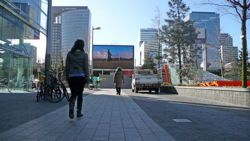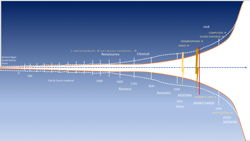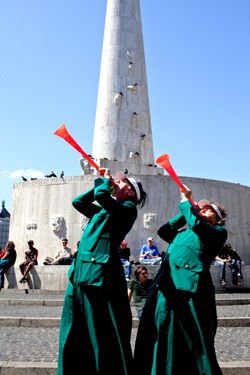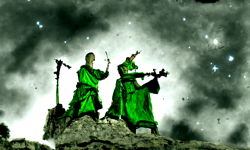Towards an Unhearable Music
Conceptualism in the ookoi’s art
eContact! 21.2 — Dematerialization of the Sounding Object: Conceptual approaches to sound-based artistic practices (July 2023) http://econtact.ca/21_2/schellinx_unhearablemusic.html
0 OK, 0:1
The “ookoi” is the name under which Dutch music / sound and media artists Peter Mertens and Harold Schellinx have been operating since the early noughties, sustaining a collaboration that goes back to the late-1970s ULTRA-scene, the Dutch twist on DIY avant-garde art and experimental post-punk pop (extensively described and documented by the author [Schellinx 2012]). The word “ookoi” is an alphabetic projection of the alphanumeric string “0 OK, 0:1”, the message that was returned by the ZX-Spectrum home computer to signal that the machine was ready to obey BASIC commands: everything is OK, there are no mistakes, one programme line has been executed. Being possibility men 1[1. “Wenn es Wirklichkeitssinn gibt, muß es auch Möglichkeitssinn geben[:] die Fähigkeit […], alles, was ebensogut sein könnte, zu denken und das, was ist, nicht wichtiger zu nehmen als das, was nicht ist.” (Musil 1978)], Mertens and Schellinx, in deliberate inversion, read this confirmation-of as an instruction-for action: the outcome of whatever of their creative deeds will be “good at once” (in Dutch: in één keer goed).

In 2004, on invitation of curator and gallerist Timo Mank, the duo in its early incarnation as a “boys band” toured Ameland, a sparsely inhabited Dutch island in the Wadden Sea to the north of the mainland. On both sides of the small touring van (Boyzz Buzz) the string “0 OK, 0:1” had been stencilled. There on the island they sang duets with the deafening cabal of thousands of sea gulls (flocks that acted as both their backing choir and sole witnesses to the performances), activated crackleboxes and other battery-powered electronic instruments while being circled by ruminating sheep tending the meadows against the embankments, cut their hair against the blowing wind on one of the island’s deserted beaches and managed to have the choir of one of Ameland’s Protestant churches perform a short text score (Fig. 1) especially composed for the occasion, titled good at once.
They marched along with the Hollumer Gromkes, a marching band based on the island’s west side, in the village of Hollum, and had the village usher loudly and publicly announce their daily artistic activities. As a consequence, the entire village was made well aware of the artists’ continued presence and ongoing activities. Given the conservatively Christian and very closed social structure of the small village community, we suspect though that few to none of the locals ever actually heard or saw them.
Rumours, local and other, early on became 0 OK, 0:1’s greatest and sought-after triumphs.
Green-Coated
It was upon their return to the mainland that they decided to collapse the text string “0 OK, 0:1” into the spelling “ookoi”, mainly because such a pluridimensional string proved quite difficult to find online using search engines of the era. With the single-dimensional “ookoi”, on the other hand, there was no such problem. The duo had by then already chosen the internet as their principal platform — a space with the potential to transcend physical place and the human timescale, providing to every single individual with an internet connection access to one’s artistic creations. 2[2. The artists’ approach clearly reflects the early naïve cyber-utopianism that, over the decade or so prior to the time of this writing, has been unveiled as just that — naïve and utopian — while being replaced at lightning speed by the dystopian reality of surveillance and digi-capitalism that exploits on a global scale to generate glamour and attention, as well as to maintain and generate astronomical wealth for a select few.]

The ookoi’s public appearances in the first decade of the new millennium were, with the exception of an occasional museal event, always geared towards cyberspace, and most often took the form of so-called placards, speculative internet headphone concerts in a format that had been introduced around the turn of the millennium by the Paris-based electronic musician Erik Minkinnen (Schellinx and Ferrand 2019). Interesting examples are the 10-hour-long Havenland Lighthouse Placard (25 May 2006), directed by the ookoi during a solitary residence inside the monumental lighthouse on the west side of the island of Ameland, and two placard events that they organized in and around the legendary Amsterdam Paradiso rock music venue. The first of these took place outside the Paradiso (25 July 2005), with a local listening space set up inside; the second (5 November 2006) was held in Paradiso’s cellar, while ultra-loud rock concerts by Lydia Lunch and by Genesis P. Orridge’s Psychic TV were going on simultaneously right above their heads.
In the spring of 2006, on the occasion of their jam karet (“time is elastic”) appearance in the Centraal Museum (Utrecht, The Netherlands), the ookoi premiered their ookoi tails, green coloured monk-like outfits craftfully designed and handmade by Bernadette Corstens and Mieke Dietvorst. Green-coated appearances from that time have branded the ookoi as the ookoi — indeed, to this very day (although at the moment, and for an as-yet-unknown period of time, we have decided to outsource all of the duo’s rare public and non-sounding appearances to ookoi clones, recruited just for such occasions) [Fig. 2].

The visual branding reflects the duo’s wish (artistic, but not only) to dematerialize, their attempt to retract into ideality, into conceptuality; to not be the ookoi, but rather an idea of ookoi, a wish that is correlated with the fact that the artists very often worked at a substantial distance from one another, in different European capitals, and hence only occasionally find themselves at converging space-time points. From the very beginning of their collaboration, the artists were confronted by the necessity, for practical reasons, to be able to “warp” time and space; it motivated their experiments in virtuality. In the very early and blooming days of the virtual world Second Life, the ookoi’s metaverse avatars performed in-world with the Avatar Orchestra Metaverse (AOM), a group of composers and sound artists writing and performing compositions specifically conceived for the digital instruments available or constructable in Second Life. These avatars also starred as protagonists in a machinima video animation — shot in a Second Life rendition of the island of Ameland, its sea and its beaches — that featured one of the ookoi’s “one-take” Future Popp tracks (Wuddy, Wuddy) as its soundtrack.
In this context we could also mention l’Écoute (2008), a one-hour wide-screen videoclip that shows the green-tailed ookoi move in rubber time across an abandoned football field on the island of Ameland. This work was made to be presented on the large public space screens in urban areas (Fig. 3) that are usually reserved for marketing and advertising purposes.
Numbers
Since time immemorial, music, numbers and the cosmos have been closer than brothers, lovers, sisters… we are living in an era in which the power of number, for better or for worse, has grown to become greater than that of gold! Every hour, every minute and every second, innumerable instances of numbers of all kinds keep popping up in headlines all over the world — pretty much any random walk through any of our planet’s cities will swamp your senses (see, hear!) with numbers, whether your attention is directed to them or not. 3[3. Such as, for example, the author’s Citynumberscapes, recorded in 2013 for broadcast by the British ResonanceFM radio station.]
It therefore is as good a guess as that of any other of today’s factions in epistemology to consider the poles in the alliteratingly awesome foursome MuMiMaMu — music, mind, mathematics and the multiverse — as being mere manifestations of one and the same. And meanwhile, musicians and composers continue counting along silently to the ticking of the internal clock that articulates the temporal progression of the piece of music that they are presently playing or conceiving. But we also encounter players or singers vocalizing numeric accentuations of elementary arithmetic and combinatorics in a large corpus of 20th- and 21st-century music, where the counting can be meant to represent music-as-structure. In these cases, in general, the range of the numbers will remain small. In Philip Glass’s Einstein on the Beach, for example, the singers sing-count up to eight, whereas in Karlheinz Stockhausen’s Helicopter String Quartet that number almost doubles. Almost! But not quite, as the Sprechgesang counting of the flying string players brings us only up to a 14. Glass and Stockhausen are but two in a panoply of examples. Stockhausen is a noteworthy example. Indeed, in several of his analysis lectures and courses (which the author has attended), he insisted in a deadly earnest manner — although always with a wicked little grin — that other composers and creators of music would be best off leaving the “aloud counting” in contemporary music to him…
This fact, along with the ookoi artists’ lifelong fascination for the numeric, for combinatorics and numerical structures 4[4. The author holds a degree in mathematics and took his first steps in computer-assisted formal composition, using strict serial techniques, as early as the early 1980s under the guidance of computer music pioneer Gottfried Michael Koenig. See Schellinx 2014, Schellinx 2022.], and the interpretation of numbers as “values” (waarden in Dutch, echte waarden: real values), led to a performance in which the ookoi could be heard reciting the first 1024 whole numbers in random order, accompanied by a continuously permuting sequence of notes and chords of a Philicorda organ. 5[5. At Intro In Situ, a centre for experimental and contemporary music in Maastricht (the Netherlands), on Sunday, 8 October 2006.]
That performance took place shortly before the ookoi’s kibibyte release 1024 in early 2007. The title is the result of the tenth power of two, a number symbolizing a fusion of the decimal and the binary, and as such represents an amalgamation of the analogue and the digital that is key to much of the ookoi’s work: The release was pressed as a DVD on which 1024 ookoi soundbites, each lasting precisely seven seconds, are organized into 64 tracks, each containing 16 markers that correspond to 16 seven-second films, each containing one of the 1024 soundbites and showing a seven-second “colour sweep” along with the soundbite’s “rank” number. Devious calculative trickery was used to produce unpredictable playback (in almost all players): the DVD reader jumps pseudo-randomly between and inside tracks. In hindsight, this programming tour de force, acted out on an already near-obsolete media format, was among the duo’s first feats in their quest for an unhearable music 6[6. The resulting curious and rather mysterious digital object was deemed by the vast majority of users to be “unplayable”; however, as a matter of fact, this was not the case.], a quest that, arguably, they kicked off in December 2006. On the occasion of the yearly BvKU (Beurs voor Kleine Uitgevers [Small Publishers Fair]) the duo had attempted what they referred to as “uptime publishing” — the act of publishing (in this case a four-hour-long piece of music) seemingly without the use of any supporting media — by directly accessing audience members’ long-term memory. 7[7. Note that “publishing” is an act of making something available. Also recall that in telecommunications and reliability theory the expected uptime of a system is represented by the product of A/(1-A) and the expected downtime, where A denotes a system’s availability.]
Countable, but Infinite
The playback of 1024 was effectively endless, in accordance with the stance that the ookoi first publicly stated in the context of their participation in a reading (in 2005) of On Kawara’s One Million Years (Past and Future): no! there will not always be a next year; but there will always be a next number!
The ookoi then took a definite and decisive turn towards the creation of a sounding art that is not so much a not-music, and not so much unheard, as it is unhearable, after the first major retrospective of their work (“Leve ookoi!” [Long Live ookoi]), staged as part of the 2007 Kunsttour (an art tour curated by Bert Lemmens) in the Dutch city of Maastricht. This change of direction eventually resulted in works like the GPS-controlled iPhone app “Hier!” 8[8. Originally released in 2014, no longer available.], a digitool that gave users access to a selection of digital versions of the duo’s good-at-once Future Popp tracks, based on their geographic location. Most of the music was unhearable at any given moment — the only way to experience the full album would be to make one’s own “European tour” to locate and listen to the individual tracks.
The History of Music

The symbiotic convergence of increasingly accessible and powerful digital technologies (Fig. 4) and the post-Duchampian assertion that any person (or maybe by extension, any entity) so inclined can call them- or itself an artist — an idea that once seemed so liberating but is now (more often than not) rather nihilating — is propelled forward and further entwined by an exponential increase in the availability of and access to seemingly endless data storage. This peculiar situation, along with the resulting unfolding of art — not unlike the blooming of a proudly vibrant flower shortly before its inevitable decay — and art forms that embrace as their basic material all that is thinkable, usable and un-usable in this world make it such that almost all music that is produced today remains unheard (just as almost all visual art remains unseen and pretty much all books that have been written remain unread).
(In earlier writings we investigated in detail the evolution of a couple of branches in this diagramme, each corresponding to “genres” practised by the author [and the ookoi]. We zoomed in on the wide and thriving practice of electroacoustic improvisation [EAI], showing that in the wider context of our culture and the history of music, EAI evolved into what we can consider to be both [borrowing terms from and based on an analogy with mathematical categories] a musical metalanguage and an historical fix point [Schellinx and Ferrand 2009]).
… Is Shaped Like a Vuvuzela

Along our timeline (Fig. 4), music spills out with an ever-widening gape in the shape of a vuvuzela. This infamously loud and noisy instrument is usually made of brightly coloured plastic and, when blown, produces a singular piercing tone somewhere around the B-flat just below middle C. Its metaphorical reference to the shape of the evolution of art and music in time were one of the main reasons the ookoi chose to fully support and promote its use and its sonority. In the eyes — and ears! — of the duo, the unstoppable and unavoidable omnipresence of the vuvuzela at the 2010 FIFA World Cup tournament in South Africa transformed four weeks of events into one massive and unique force — and a truthful audiovisual representation of the art of music and sound as it is encountered today.
It gave content and form to what may well have been the ultimate within the ookoi’s corpus of hearable works. Appropriately baptized The Final Soundtrack, it has four movements like a classical symphony, but is completed with a fifth movement, a free-from recapitulating epilogue. The first four movements are built from a minimally edited, full in-stadium field recording of the 2010 FIFA World Cup final between Spain and the Netherlands, featuring a massive vuvuzela section that would have caused Richard Wagner to blush in utter envy.
In each of the first three movements the listener hears a number of repetitive vuvuzela patterns, all leading up to and preparing for the fourth movement: with the score remaining at 0–0 throughout the two halves of the match, the tension of the approaching end time drives the orchestral dynamics to near-explosive heights. The movement and the symphony proper end with the outburst of the stadium choir marking Spain’s match-winning goal in extra time. It is followed by a four-minute epilogue, a dazzling chronological collage of all the preceding referee whistles and ball kicks (Audio 1).
b.ookoi
In 2015 the ookoi started writing and editing the b.ookoi, a labyrinthian and encyclopaedic print publication that covers all of their acts, works and proceedings from the very early 1980s onwards, in 1024 numbered paragraphs, distributed over 1024 pages and divided into 4 volumes of 256 pages each, according to a single, contingent listing of the first 210 natural numbers.
It is an ongoing work, one however that attempts — in a way — to undo all that the ookoi did before.
Sort of a Don Quixotean task.
In the midst of a hurricane, one may well realize that it would have been best to stay far from its raging powers, but often by then harm has already been done. The realization that one has arrived at a point in history where the concept of not making art (which, mind you, is not in the least related to that of making not-art) in a truly profound sense has come to stand out as the one remaining veritable art form spawns a deceptive paradox: one has to have made art in order to realize that in order to make art one should never have made art in the first place. Ipso facto, truly sincere artists of the future never were, nor will they ever be, artists.

It is, in conclusion, interesting to observe how closely the use of textual “prompts” in the intriguing text-to-image generating AI diffusion models (which are rapidly gaining popularity and will undoubtedly soon be adapted to also enable text-to-sound and text-to-music generation) are related to some early conceptual pieces of music. Like La Monte Young’s Draw a Straight Line and Follow It, like the scores for Karlheinz Stockhausen’s “intuitive music” and like Yoko Ono’s Fluxus work, these textual prompts are concepts. Concepts — and thus a fortiori all conceptual art — enter and explore the Borgesian space (Basile 2018) of permutational possibilities contained within a specific set of noise, which can be understood as the union of all possible realizations of the concept.
The b.ookoi is also a prompt.
It is a concept, awaiting realization.
Bibliography
Basile, Jonathan. Tar for Mortar: “The Library of Babel” and the dream of totality. Earth: Punctum Books, 2018. http://doi.org/10.21983/P3.0196.1.00
Musil, Robert. Der Mann ohne Eigenschaften. Reinbek bei Hamburg: Rowolt, 1978.
Schellinx, Harold. “The Art of K7 :: Sudokaising.” SoundBlog. HarsMedia, 21 March 2010. http://www.harsmedia.com/SoundBlog/Archief/00854.php [Accessed 8 April 2023]
_____. ULTRA: Opkomst en ondergang van de Ultramodernen, een unieke Nederlandse muziekstroming (1978–1983). Amsterdam: Lebowski Publishers, 2012.
_____. “The Eerie Symmetry of a Perfect Ping [Or, taking a bunch of cowbells and dropping them down the stairs].” SoundBlog. HarsMedia, 1 December 2014. http://www.harsmedia.com/SoundBlog/Archief/00814.php [Accessed 8 April 2023]
_____. “Dáár zit de muziek. Het Bacchiaanse werk van Gottfried Michael Koenig.” Gonzo (Circus) Magazine 168 (March–April 2022), pp. 24–26.
Schellinx, Harold and Emmanuel Ferrand. “Az elektroakusztikus improvizáció́ mint metanyelv és rögzített pont [Electroacoustic Improvisation as Metalanguage and Fixed Point].” In Médium Hang Esztétika — Zeneiség a mediális technológiák korában. Edited by Batta Barnabás. Szeged: University of Szeged (2009), pp. 57–80.
_____. “Freely Improvised and Non-Academic Electroacoustic Music by Urban Folks.” RE:SOUND 2019. Proceedings of the 8th International Conference on Media Art, Science and Technology (Aalborg, Denmark: Aalborg University, 20–23 August 2019). http://doi.org/10.14236/ewic/RESOUND19.26
Social top